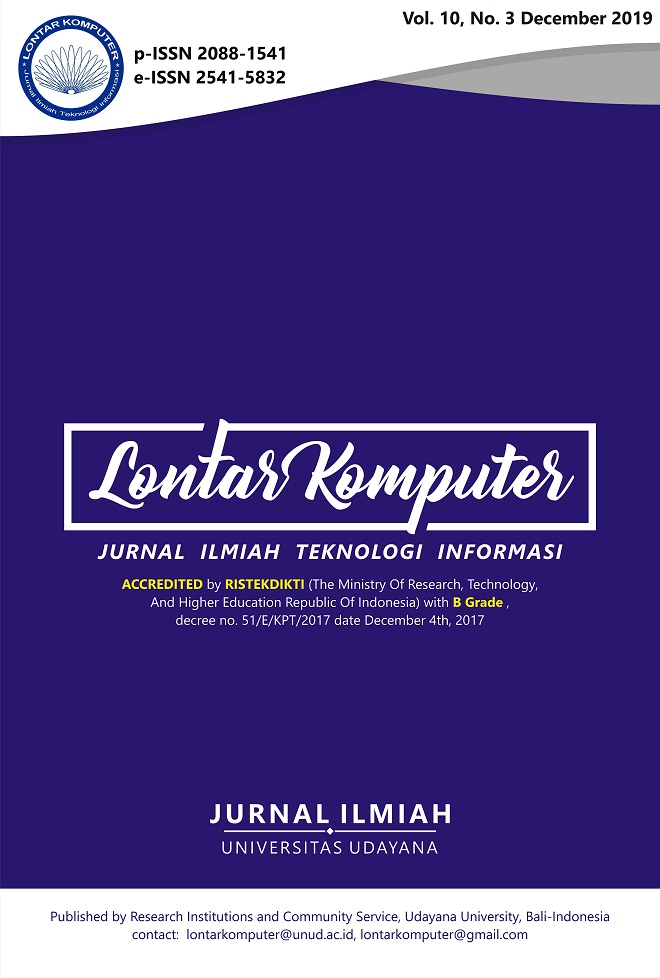Development of Graphical Interface System for Inverted Pendulum Stabilization
Abstract
Currently, most of basic control engineering lectures teach both mathematic model and control of an inverted pendulum to explain stability problems in dynamic systems. The inverted pendulum system is a pendulum controlled with a certain force in order to stand in balance around vertical equilibrium line. Hence this system is a highly unstable system and needs stabilization methods using a kind of controller. This paper describes how to design a Proportional Derivative Integral (PID) controller via root locus technique to stabilize it and realization of its interface system for monitoring angle trajectory. This visualization is needed to observe the stability and effectiveness of its mathematic model and control design. Experimental results and analysis show that control design and interface system can be implemented well.
Downloads
References
pendulum,” in 2017 IEEE International Conference on Power, Control, Signals and Instrumentation Engineering (ICPCSI), pp. 2728–2733, Sep. 2017.
[2] M. Antonio-Cruz, V. M. Hernández-Guzmán, and R. Silva-Ortigoza, “Limit cycle elimination in inverted pendulums: Furuta pendulum and pendubot,” IEEE Access, vol. 6, pp. 30317–30332, 2018.
[3] S. Kim and S. Kwon, “Nonlinear optimal control design for underactuated two-wheeled inverted pendulum mobile platform,” IEEE/ASME Transactions on Mechatronics, vol. 22, pp. 2803–2808, Dec 2017.
[4] H. Fukushima, K. Muro, and F. Matsuno, “Sliding-mode control for transformation to an inverted pendulum mode of a mobile robot with wheel-arms,” IEEE Transactions on Industrial Electronics, vol. 62, pp. 4257–4266, July 2015.
[5] H. Ouyang, J. Wang, G. Zhang, L. Mei, and X. Deng, “Novel adaptive hierarchical sliding mode control for trajectory tracking and load sway rejection in double-pendulum overhead cranes,” IEEE Access, vol. 7, pp. 10353–10361, 2019.
[6] Shiuh-Jer Huang and Chien-Lo Huang, “Control of an inverted pendulum using grey prediction model,” IEEE Transactions on Industry Applications, vol. 36, pp. 452–458, March 2000.
[7] N. N. Nise, Control System Engineering. John Wiley & Sons, Inc, 2011.
[8] A. S. Wibowo and E. Susanto, “Performance improvement of water temperature control using anti-windup proportional integral derivative,” Lontar Komputer Jurnal Ilmiah Teknologi Informasi, pp. 81–94, 2018.
[9] “[25 years ago],” IEEE Control Systems Magazine, vol. 38, pp. 10–11, Oct 2018.
[10] M. Ghosh, S. Ghosh, P. Saha, and G. Panda, “Design and implementation of pic16f877a
microcontroller-based data acquisition system with visual basic based GUI,” in 2016 7th International Conference on Intelligent Systems, Modelling and Simulation (ISMS), pp. 419–423, Jan. 2016.
[11] M. David and N. Y. Dahlan, “Development of visual basic based GUI for option an energy savings of ipmvp,” in 2014 IEEE 4th International Conference on System Engineering and Technology (ICSET), vol. 4, pp. 1–6, Nov 2014.
[12] K. A. Othman, M. A. H. M. Isa, M. A. Baharuddin, M. A. Ghazali, Z. I. Khan, and N. A. Zakaria, “Forest monitoring system implementation using visual basic and android application,” in 2018 18th International Symposium on Communications and Information Technologies (ISCIT), pp. 447–451, Sep. 2018.
[13] J. C. Martínez-Santos, O. Acevedo-Patino, and S. H. Contreras-Ortiz, “Influence of arduino
on the development of advanced microcontrollers courses,” IEEE Revista Iberoamericana deTecnologias del Aprendizaje, vol. 12, pp. 208–217, Nov 2017.
The Authors submitting a manuscript do so on the understanding that if accepted for publication, the copyright of the article shall be assigned to Jurnal Lontar Komputer as the publisher of the journal. Copyright encompasses exclusive rights to reproduce and deliver the article in all forms and media, as well as translations. The reproduction of any part of this journal (printed or online) will be allowed only with written permission from Jurnal Lontar Komputer. The Editorial Board of Jurnal Lontar Komputer makes every effort to ensure that no wrong or misleading data, opinions, or statements be published in the journal.
 This work is licensed under a Creative Commons Attribution 4.0 International License.
This work is licensed under a Creative Commons Attribution 4.0 International License.























